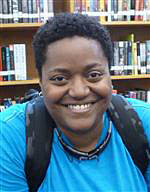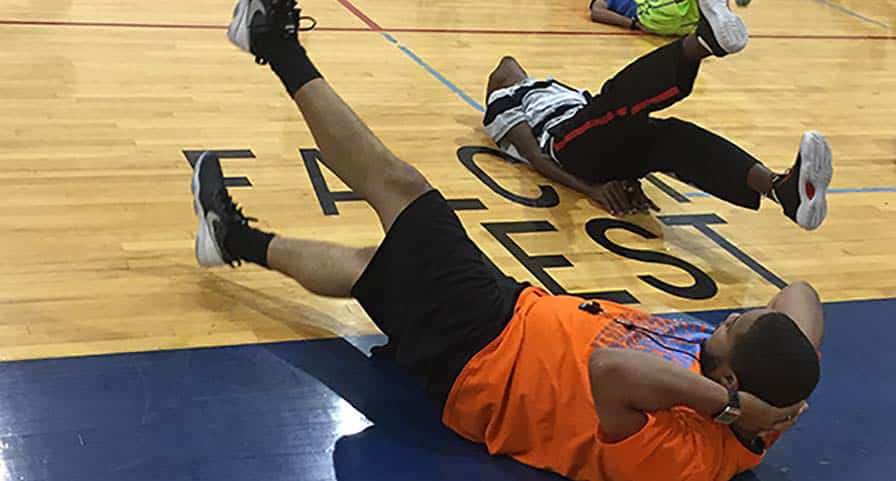Of the schools using the IHT Spirit System, Maceo Smith students produced some of the most positive results. Students wore the Spirit System heart rate monitors for 74 days during the year. In those workouts, students spent 80.5 percent of their time at an elevated heart rate, 35.5 percent of which came in the red – or optimal – heart rate zone and burned more than 2 million calories, 2,259,486 to be exact. Of the five other schools to burn at least 1 million calories during PE, Smith reached that mark in 135 fewer sessions – individual student workouts – than the others.
‘We go to work!’
“We go to work here!” McClennon said the day after students left for the summer. Her class won last fall’s IHT Spirit Challenge and continued to perform well as the year continued. “By the time we do our stretches and go into the group exercises, they are already in their red zones, for most students.”

Those exercises are designed to get the students working hard quickly. McClennon said she wants her classes to never be at rest – to always be working out in the yellow (moderate exertion) or red (optimal exertion) zones. That’s how she sets the daily goals.
“Mostly it’s 60-70 percent in yellow and the rest of it in the red,” she said. “In the beginning, that helps them see what they are doing when they reach their goals. It’s not hard to get into the red zone, and it’s really not hard to get in the yellow zone.”
For her mandatory freshman and sophomore PE classes, the exercise regimen consists of traditional exercises – push ups, sit ups, crunches, squat-thrusts to name a few. Then McClennon sends the students to play various games, both traditional and non-traditional. She’ll try anything as long as the students continue to work hard.
“We want every kid to be active, want every kid to feel included,” she said. “We do a lot of non-traditional sports. We try to find games where we can get as many kids as active as possible to play, like capture the flag. We invented a game called Call to Duty. Anything with foam balls, they love. Coach [William] Pittman had us playing a new game with a football, but you throw it into a lacrosse net. It’s fun, and you have 30 kids active at the same time.”
Students engage with technology
For the freshmen and sophomores, McClennon found that the marriage between playing fun games and having access to technology that tells students how hard they are working has been perfect.
“I saw quite a few kids really engage after seeing the data,” she said. “After they see the red and see themselves pushing themselves and see the data, then they start getting excited about meeting their goal, about coming in telling me, ‘coach, I met my goal today, and I had fun doing it!’ That’s special. When they make their goal and all they did was have fun. We’ve seen kids get happier and happier about reaching their goals, asking if their individual goal can be changed.”
That student ownership continues. This past year Smith added a PE elective open to juniors and seniors. The class filled, and McClennon saw that the work she’d done the last two years had made a big impact on the students who returned to PE.
“Those kids were given a choice,” she said. “Every six weeks they submitted a workout plan of what they wanted to do. Each week they had to set goals and turn them in. A lot of those goals were based on what they wanted to see on their heart-rate data. What I found was actually giving them the choice and letting them plan their own workout, they actually were always reaching and exceeding their goals. They’d come in, put their monitors on and get right to work. That was very encouraging.”
And the results show.
By embracing data, A. Maceo Smith New Tech HS students work harder to reach goals
McClennon said having access to the Spirit System data – the student’s own individual data – is key to the program’s success.
“The data works for the kids,” she said. “We can talk to them all day about lots of different things, about how it’s important to be healthy. But them being able to see it, and see results, makes a big difference. It’s huge, and that’s across the board. They want to reach the goals. They want to see the calories being burned.”
McClennon said the students aren’t just learning about working hard in PE today. By embracing the data they receive, they’re building a foundation for healthy living down the road.
“We talk about data a lot as teachers – we’ve got to have data – but the kids actually having the data means a world of difference,” she said. “It allows them to take ownership of their health for themselves. Once they get that ownership and become responsible for it, it makes my job so much easier.”


